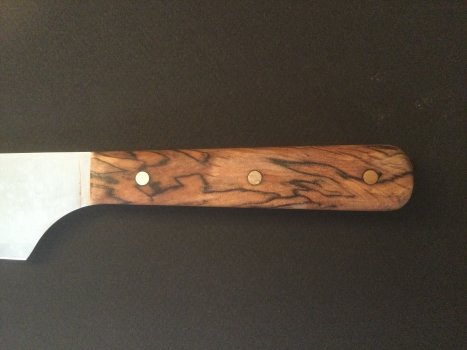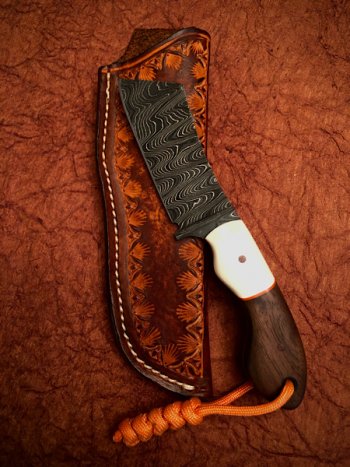Hey all. Need some help with a finishing problem on handles. So, I’m making full tang kitchen knives with stabilized wood and 3/16 brass pins, sanded flush. Also using epoxy between blade and back of the scales. When I sand/contour the scales I’ll start with the grinder then move to a flat stick with a strip of finer sand paper glued to the stick. Everything’s cool to this point and I quit at about 400-600 grit. Then when I go to the buffer I’m seeing small imperfections in line between the pins. Like, a little pathway that looks like it wasn’t well sanded right in line with the pins. . Assume this is because the pins are shedding brass particles into the abrasive path and actually scratching the softer handle material? And, this doesn’t always happen. Go figure!
It’s not radical and you’d need to have a pretty well trained eye to pick this up, but YOURS TRULY notices. Have tried other finish sanding methods, like a small random orbit sander but that tends to leave the handle material lower than the pins, causing an uneven surface that emphasizes the dang pin. This problem only becomes apparent when I use the buffer so could it be a buffing problem? If there was an alternative to polishing the pins I’d try that but old Mr. Buffer does such a good job overall.
The example here is typical for me. Handle is stabilized, spalted red alder. steel is stainless 440C equivalent. Any help greatly appreciated.
It’s not radical and you’d need to have a pretty well trained eye to pick this up, but YOURS TRULY notices. Have tried other finish sanding methods, like a small random orbit sander but that tends to leave the handle material lower than the pins, causing an uneven surface that emphasizes the dang pin. This problem only becomes apparent when I use the buffer so could it be a buffing problem? If there was an alternative to polishing the pins I’d try that but old Mr. Buffer does such a good job overall.
The example here is typical for me. Handle is stabilized, spalted red alder. steel is stainless 440C equivalent. Any help greatly appreciated.


